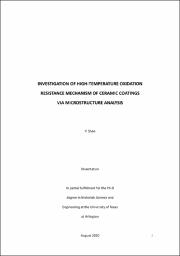
ATTENTION: The works hosted here are being migrated to a new repository that will consolidate resources, improve discoverability, and better show UTA's research impact on the global community. We will update authors as the migration progresses. Please see MavMatrix for more information.
Show simple item record
| dc.contributor.advisor | Meletis, Efstathios | |
| dc.contributor.advisor | Jiang, Jiechao | |
| dc.creator | Shen, Yi | |
| dc.date.accessioned | 2020-09-10T17:56:07Z | |
| dc.date.available | 2020-09-10T17:56:07Z | |
| dc.date.created | 2020-08 | |
| dc.date.issued | 2020-09-03 | |
| dc.date.submitted | August 2020 | |
| dc.identifier.uri | http://hdl.handle.net/10106/29428 | |
| dc.description.abstract | Recent developments of ceramic coatings deposited using magnetron reactive sputtering show that these films exhibited superior high-temperature oxidation resistance along with other desirable properties such as high hardness, optical transparency and good electrical conductivity. Detailed microstructure study of these films annealed to high temperatures using transmission electron microscopy (TEM) is deemed necessary as it provides an intuitive vision on the behavior of the materials at elevated temperature, which is essential to further improve their high-temperature oxidation resistance. In this study, Hf-B-Si-C-N films with various compositions that were annealed to various temperatures in both helium and air were subjected to detailed TEM study. The results showed that while as-deposited films exhibited amorphous structure, annealing in air resulted in the formation of an oxide layer on top and the original film underneath. Meanwhile, annealing in helium led to partial recrystallization of the film into a nanocrystalline composite structure without oxidation. It was also observed that the addition of nitrogen helped the amorphization of the film at high temperatures and could potentially improve the oxidation resistance. Further improved design of the Hf-B-Si-C-N films can be accomplished with the addition of rare earth elements including yttrium and holmium, as well as tuning of silicon and boron content. The effects of these changes were also subjected to TEM microstructure analysis, in an effort to uncover the high temperature oxidation resistance mechanism. It is concluded that Hf6B21Si19C4N47 film, which exhibited superior thermal stability at high temperatures, had a relatively smooth and defect-free interface between the oxide layer and bottom layer, which in turn offer the best oxidation resistance among the films we have studied. | |
| dc.format.mimetype | application/pdf | |
| dc.language.iso | en_US | |
| dc.subject | Thin films | |
| dc.subject | TEM | |
| dc.subject | Oxidation resistance | |
| dc.subject | Microstructures | |
| dc.title | INVESTIGATION OF HIGH-TEMPERATURE OXIDATION RESISTANCE MECHANISM OF CERAMIC COATINGS VIA MICROSTRUCTURE ANALYSIS | |
| dc.type | Thesis | |
| dc.degree.department | Materials Science and Engineering | |
| dc.degree.name | Doctor of Philosophy in Materials Science and Engineering | |
| dc.date.updated | 2020-09-10T17:56:08Z | |
| thesis.degree.department | Materials Science and Engineering | |
| thesis.degree.grantor | The University of Texas at Arlington | |
| thesis.degree.level | Doctoral | |
| thesis.degree.name | Doctor of Philosophy in Materials Science and Engineering | |
| dc.type.material | text | |
| dc.creator.orcid | 0000-0002-6864-3235 | |
Files in this item
- Name:
- SHEN-DISSERTATION-2020.pdf
- Size:
- 14.85Mb
- Format:
- PDF
This item appears in the following Collection(s)
Show simple item record


